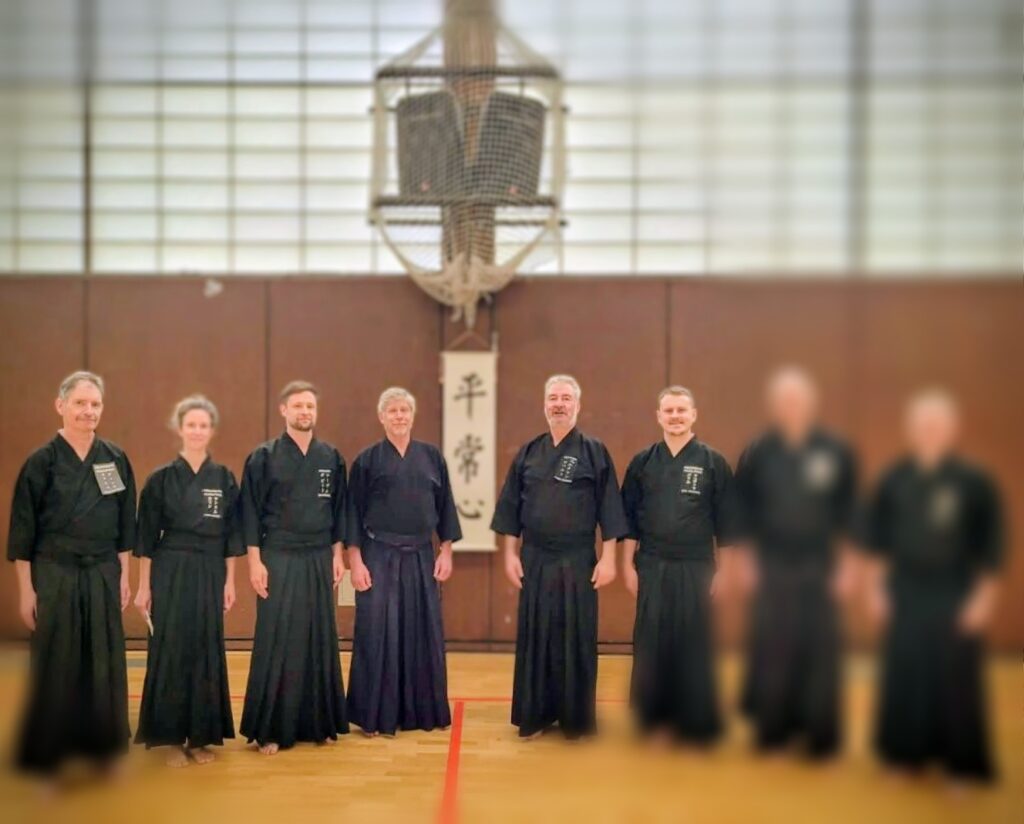Heijoshin Huglfing nahm am jährlichen Iaido-Seminar mit René van Amersfoort sensei in München teil. Für manche war es der erste Lehrgang überhaupt; für andere bereits Tradition!

Übungsleiter David Siegel hat einen Bericht darüber geschrieben:
Aikido Yoshinkan‘s iaido seminar with René van Amersfoort Sensei (kyoshi 7th dan iaido, kyoshi 8th dan jodo) in the summer of 2025 (from 23rd to 24th of August) took place in Munich (Germany), where the dojo is located.
The following is just a small summary of the many points, deep topics and big body of information sensei brought with him to share.
SATURDAY
The »do« in iaido refers to the way we pursue in our martial art employing the Japanese sword. So René-sensei walked us into the seminar.
The group was complete early. Therefore he started 10 minutes early in a non-formal way.
Sensei asked another accomplished karateka to exchange some stabs with him. Mitori keiko on
relaxation, okori and reach (or the zone one is able to control). From there his focus shifted to walking: one of the most basic conscious movements.
Sensei was remarking the different approaches in footwork, use of the knees, the shift of weight and again body relaxation.
Then he formally opened the seminar.
We started with reiho and etiquette in the form of small comments on the formal greetings by sensei. He asked not only for the correct way to perform reiho, but also showed how to stay relaxed in the shomen ni rei. The kamae keitoshisei, tai to no kamae and tei to no kamae were repeated and differentiated.
René-sensei was assisted by Robert Völkmann sensei (renshi 6th iaido), Rainer Brocks sensei (6th dan iaido) and Felix Klein sensei (6th dan iaido).
Throughout the seminar these sensei were complemented by two Iaidoka going for rokudan at the upcoming EIC.
Cutting
We didn‘t start with a set of 10.000 suburi at the highest speed possible!
We started slowly to enable everyone in the dojo to hold on to a relaxed body and cut from the core, not the shoulders nor the arms.
It took us quite some time to get to „standard suburi“, but the difference in every sword being drawn, in every cut and noto being made was visible and foremost audible. As the koiguchis of everyone were unusually calm and silent.
Among many other points, sensei reminded of the proper stance in iaido: issoku cho han (2 x 1.5 feet wide).
Kata
We started with a kata derived from the martial art of taichi and arrived in Europe through Ogura-sensei and Kinamoto-sensei: unjung. The focus of this form should be placed on relaxed, fluent motions and proper timing.
ZNKR kata
After the lunch break we started with the four ZNKR sitting kata (1-2-3-4).We trained in pairs facing each other and different speed levels:
- „regular“
- slow motion
- fast
- slow parts slow and fast parts fast,
- everything brought together into a „new regular“.
The day was finished with the standing ZNKR kata (5 to 12).

EVENING
As always we gathered at the Alpenhof, an Italian restaurant, and had a lot of good food as well as some refreshing beverages.
I can only speak for myself, but I got to know fine folks from Switzerland and we talked about our teachers, lineage, the Ishido family, shared friends and other connections. Kokenchiai all the way!
A good, relaxed time.
SUNDAY
Again we started with cutting exercises focusing on relaxation and power from the core. An important point in the preparation for the suburi was the work as a group, not the individual iaidoka. This began in the distribution of space within the training hall using a certain system established by sensei.
After the lunch break the rokudan and the candidates aspiring to that grade showed the omori ryu aka shoden series of the muso shinden ryu taught by Ishido-sensei. René-sensei again and again referred to an old video of kanchō-sensei performing all MSR Kata and muso jikiden eishin-ryu exploring and showcasing lineage as well as passing on knowledge from teacher to student and keeping true to this information.
Sensei’s assistants showed their koryu (shoden up to ryuto and hayanuki from chuden).
After several runs through koranto (no stops through relaxation!), the main body of the students trained ZNKR from there on as nowadays these 12 kata make up the basis, the first step in iaido.
In every kata and each kihon therein sensei wanted to see the main point of the seminar executed: relaxation and power from the core.
The seminar was finished with a full set ZNKR kata1 to 12 dan group facing dan group: 6 to 5, 4 to 3, 2 to 1, with the mudan performing face into the dojo.
Thank you very much René-sensei once again for a deep, deep lecture with so many details and so much richness!
Please note that the summarized event, information and advice may be specific to our style, repeated incomplete and/or misinterpreted by the author.
Report by David Siegel
(4th dan iaido, 5th dan jodo)